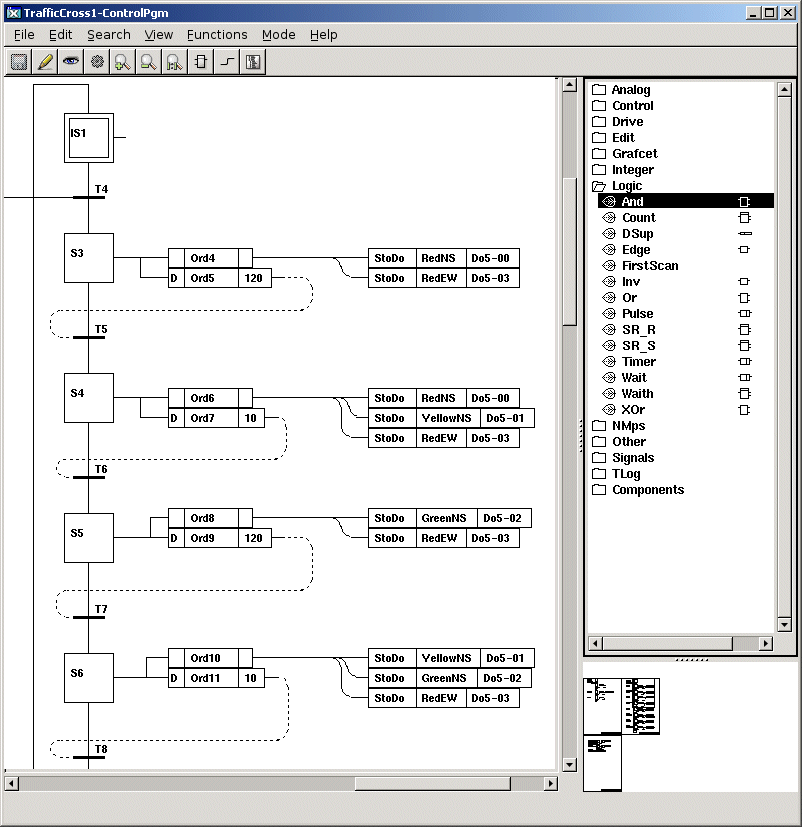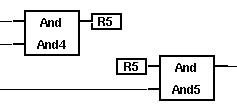| File/Save | | Save
|
| File/Print/Documents | | Print all documents
|
| File/Print/Overview | | Print an overview
|
| File/Print/Selected documents | | Print selected documents
|
| File/Syntax | | Perform a syntax check of the code
|
| File/Build | | Compile the program
|
| File/Plc Attributes | | Open the Object editor for the PlcPgm object
|
| File/Delete Window | | Delete the plc window
|
| File/Save Trace | | Save trace objects
|
| File/Restore Trace | | Restore previously saved traceobjects
|
| File/Close | | Close the window
|
|
|
| Edit/Undo Delete | | Undo the last delete action
|
| Edit/Undo Select | | Reset the select list
|
| Edit/Cut | | Cut selected objects
|
| Edit/Copy | | Copy selected object to the paste buffer
|
| Edit/Paste | | Copy the paste buffer to the work area
|
| Edit/Connect | | Connect selected object to the selected signal or attribute
|
| | | in the configurator
|
| Edit/Delete | | Delete selected objects
|
| Edit/Change Text | | Change text in the selected text object
|
| Edit/Expand Object | | Expand the selected object
|
| Edit/Compress Object | | Compress the selected object
|
|
|
| Search/Object | | Search for an object name
|
| Search/String | | Search for a string
|
| Search/Next | | Search further with the same string
|
|
|
| View/Palette/Object | | Display the functions object palette
|
| View/Palette/Connection | | Display the connection palette
|
| View/Palette/Plant | | Display the plant hierarchy
|
| View/Reference connections | | Create connections as reference connections
|
| View/Grid Size | | Set grid size
|
| View/Show Grid | | Show the grid
|
| View/Zoom/In | | Zoom in
|
| View/Zoom/Out | | Zoom out
|
| View/Zoom/Reset | | Reset to original zoom factor
|
| View/Show Execute Order | | Show execute order for the functions objects
|
| View/Redraw | | Redraw connections and redraw the window
|
|
|
| Functions/Open Object | | Open the object editor for the selected object
|
| Functions/Subwindow | | Open the subwindow for the selected object
|
|
|
| Mode/View | | View mode
|
| Mode/Edit | | Edit mode
|
| Mode/Trace | | Trace mode
|
| Mode/Simulate | | Simulate mode
|
|
|
| Click MB1 | | Select an object. Click in an empty space will reset the select list
|
| Shift/Click MB1 | | Add object to the select list
|
| DoubleClick MB1 | | Open object editor
|
| Shift+Ctrl/DoubleClick MB1 | | Copy to past buffer. Click in an object
|
| | | copies the object, click in empty space copies selected objects
|
| Drag MB1 | | On an object: move object or move selected objects
|
| | | In empty space: select objects inside the marked rectangle
|
| Shift/Drag MB1 | | Add objects inside the marked rectangle to the select list
|
|
|
| Click MB2 | | Create object
|
| DoubleClick MB2 | | Delete. Click in object deletes the object, Click
|
| | | in empty space deletes all the selected objects
|
| Shift+Ctrl/Click MB2 | | Paste. Copy the paste buffer to the working area
|
| Shift+Ctrl/DoubleClick MB2 | | Cut. Click in an object deletes the object, click
|
| | | in an empty space deletes selected objects. Deletet object are put
|
| | | in the paste buffer
|
|
|
| Press MB3 | | Popup menu
|
|
|




